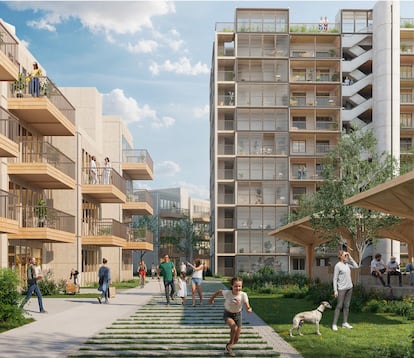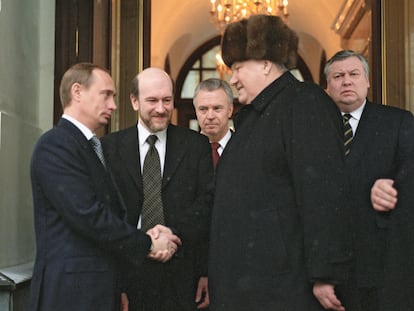Mission: Rebuilding Kharkiv
The competition called by the Norman Foster Foundation already has a winning project to build the future of the destroyed Ukrainian city

Evoking the famous line by the Spanish novelist Pío Baroja — every day hurts, except the last one, which kills — there are four hurtful dates marked on Kharkiv’s calendar: May 19, September 16, October 3, October 29. On those days, Russia used guided missiles against the civilian population of the Ukrainian city. Adults died, and children aged eight, 13 and 16 were injured. The country’s second-largest city, Kharkiv is also the closest of Ukraine’s large cities to the Russian border (around 18 miles or 30 kilometers), and it has not enjoyed peace for the more than 1,000 uncertain days of invasion by Putin’s armies and mercenaries. Against barbarism, the answer is culture. This response lives on in the thought of Norman Foster, one of the best architects of our time.

Foster explains it for the first time through a signed document that he sent to EL PAÍS. In 2022, at the United Nations, he was approached by the mayor of Kharkiv, Ihor Terekhov, and asked to create a model of a city that could be replicated in other parts of the country when the war ends. Foster accepted. He started a non-profit project through his Madrid-based foundation, of which he is president, and from London he picked up the phone to dial the number for Stuart Smith, director in Berlin of the engineering company ARUP.
He also contacted two highly prestigious economists: Edward Glaeser (Harvard) and Ian Goldin (Oxford). They in turn consulted citizens through hundreds of meetings and questionnaires, in which they explained how they imagined the city without the devastation. There will be money available for the project, since in the short term Europe is contributing €45 billion ($46.7 billion) for the reconstruction of Ukraine together with the interest on the $300 billion of frozen Russian assets.
Two years after that phone call, the winning proposals for this new city have been chosen from among 259 candidates (including 27 from Ukraine) from 53 countries. The pilot project had to be based on “heritage, homes, nature, industry and a technology district,” explains Foster. He adds: “The master plan and the pilot projects are supported by the German government and the United Nations.”
The first prize has been awarded to the project Healing Kharkiv: From rubble to renewal, by the U.K. design engineer Andrew James Jackson. It uses materials salvaged from destroyed structures, increases security, incorporates terraces and gardens, and the public spaces have underground shelters and rainwater collection systems. The second choice is Blooming towards the sun, by Zigeng Wang, whose title refers to sunflowers, a symbol of resistance and national pride. And the third option is Modus Vita (Style of Living), by three architects from Yildiz Technical University (Turkey) who proposed an adaptable modular system of underground shelters built from high-strength concrete panels. They all drew their proposals with war in mind.
There are words full of hope, such as reconstruction, in a country where Russia has taken 19% of its land and razed its sunflower fields to the ground. But the future is already counting down the days. “Preservation of nature and rivers, improvements in housing and a neighborhood that combines residences, leisure spaces, schools, universities and facilities for teaching and industry. It is a vision of the future, rooted in the present and aware of the past,” says Norman Foster, covering all historical eras in one sentence.
Sign up for our weekly newsletter to get more English-language news coverage from EL PAÍS USA Edition
Tu suscripción se está usando en otro dispositivo
¿Quieres añadir otro usuario a tu suscripción?
Si continúas leyendo en este dispositivo, no se podrá leer en el otro.
FlechaTu suscripción se está usando en otro dispositivo y solo puedes acceder a EL PAÍS desde un dispositivo a la vez.
Si quieres compartir tu cuenta, cambia tu suscripción a la modalidad Premium, así podrás añadir otro usuario. Cada uno accederá con su propia cuenta de email, lo que os permitirá personalizar vuestra experiencia en EL PAÍS.
¿Tienes una suscripción de empresa? Accede aquí para contratar más cuentas.
En el caso de no saber quién está usando tu cuenta, te recomendamos cambiar tu contraseña aquí.
Si decides continuar compartiendo tu cuenta, este mensaje se mostrará en tu dispositivo y en el de la otra persona que está usando tu cuenta de forma indefinida, afectando a tu experiencia de lectura. Puedes consultar aquí los términos y condiciones de la suscripción digital.
More information
Archived In
Últimas noticias
The complicated life of Francesca Albanese: A rising figure in Italy but barred from every bank by Trump’s sanctions
How Japan is trying to avert ‘digital defeat’
Half of Scotland is in the hands of 420 property owners
Reinhard Genzel, Nobel laureate in physics: ‘One-minute videos will never give you the truth’
Most viewed
- Pablo Escobar’s hippos: A serious environmental problem, 40 years on
- Why we lost the habit of sleeping in two segments and how that changed our sense of time
- Charles Dubouloz, mountaineering star, retires at 36 with a farewell tour inspired by Walter Bonatti
- Reinhard Genzel, Nobel laureate in physics: ‘One-minute videos will never give you the truth’
- The Florida Keys tourist paradise is besieged by immigration agents: ‘We’ve never seen anything like this’











































